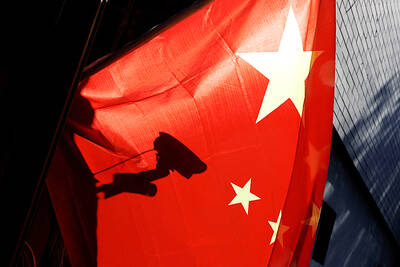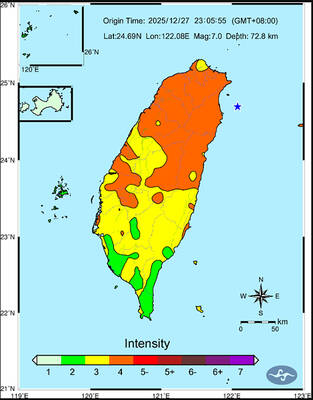Visiting patients with chronic illnesses at hospitals can be allowed under certain conditions, the Central Epidemic Command Center (CECC) said yesterday, as it reported one locally transmitted COVID-19 infection and 10 imported cases.
Centers for Disease Control Deputy Director-General Chuang Jen-hsiang (莊人祥), the CECC’s spokesman, said as a local COVID-19 outbreak is steadily coming under control, the CECC on Sunday informed local governments to notify healthcare facilities that they could conditionally reopen chronic disease wards to visitors.
Visits to patients in intensive care units, hospice and palliative care divisions, respiratory care wards, psychiatric divisions, pediatric wards and those with a mental impairment or in a critical condition had previously been allowed.

Photo: CNA
Visitors to chronic disease wards must not have COVID-19-related symptoms, should not have had direct contact with a COVID-19 patient or visited public spaces where COVID-19 patients were during their contagious period, must wear a mask during the visit and practice good hand hygiene, Chuang said.
There is to be one designated visiting period per day and no more than two people are allowed to visit a patient at the same time, he said.
All visitors must present a negative COVID-19 rapid antigen test or polymerase chain reaction (PCR) test from within the past three days, he added.
Visitors are exempted from taking the tests under two conditions: if they have been fully vaccinated and received the last dose more than 14 days earlier, or if they have been released from isolation after being infected within three months of the onset of symptoms, Chuang said.
The local case of COVID-19 is a woman in her 40s who lives in New Taipei City and is a teacher at a preschool in Taipei’s Neihu District (內湖), Chuang said.
The woman tested positive for COVID-19 at a hospital on Saturday when seeking medical attention for other reasons. The test had a high cycle threshold value of 34.9, he said.
Serological antibody testing also showed a negative IgM antibody and positive IgG antibody result, and was positive for antibodies against the spike and nucleocapsid proteins of SARS-CoV-2, Chuang said, adding that the case is likely a previous infection.
The woman took another PCR test yesterday, which was negative, he said.
The local health department has identified 98 close contacts of the woman and placed 67 of them in isolation, one under self-health management and 30 under self-health monitoring, he added.
The 67 contacts in isolation are the woman’s students and their parents, and they would all be tested for COVID-19, Chuang said.
The 10 imported cases arrived in Taiwan from Indonesia, Singapore, the Philippines and the US, he said.
Meanwhile, first doses of the Pfizer-BioNTech vaccine and second doses of the AstraZeneca and the Moderna vaccine are expected to be offered in the 12th round of vaccination, in which appointments can be made from Monday to Wednesday next week for inoculations from Friday next week to Oct. 31, Chuang said.
In the 12th round, all age groups are likely to be eligible for the Pfizer-BioNTech vaccine, while those eligible for a second dose of the Moderna vaccine are likely to be people who received a first dose on or before July 16, he said.
The confirmed details of the 12th round of vaccinations would be announced soon, he added.

A magnitude 7.0 earthquake struck off Yilan at 11:05pm yesterday, the Central Weather Administration (CWA) said. The epicenter was located at sea, about 32.3km east of Yilan County Hall, at a depth of 72.8km, CWA data showed There were no immediate reports of damage. The intensity of the quake, which gauges the actual effect of a seismic event, measured 4 in Yilan County area on Taiwan’s seven-tier intensity scale, the data showed. It measured 4 in other parts of eastern, northern and central Taiwan as well as Tainan, and 3 in Kaohsiung and Pingtung County, and 2 in Lienchiang and Penghu counties and 1

FOREIGN INTERFERENCE: Beijing would likely intensify public opinion warfare in next year’s local elections to prevent Lai from getting re-elected, the ‘Yomiuri Shimbun’ said Internal documents from a Chinese artificial intelligence (AI) company indicated that China has been using the technology to intervene in foreign elections, including propaganda targeting Taiwan’s local elections next year and presidential elections in 2028, a Japanese newspaper reported yesterday. The Institute of National Security of Vanderbilt University obtained nearly 400 pages of documents from GoLaxy, a company with ties to the Chinese government, and found evidence that it had apparently deployed sophisticated, AI-driven propaganda campaigns in Hong Kong and Taiwan to shape public opinion, the Yomiuri Shimbun reported. GoLaxy provides insights, situation analysis and public opinion-shaping technology by conducting network surveillance

‘POLITICAL GAME’: DPP lawmakers said the motion would not meet the legislative threshold needed, and accused the KMT and the TPP of trivializing the Constitution The Legislative Yuan yesterday approved a motion to initiate impeachment proceedings against President William Lai (賴清德), saying he had undermined Taiwan’s constitutional order and democracy. The motion was approved 61-50 by lawmakers from the main opposition Chinese Nationalist Party (KMT) and the smaller Taiwan People’s Party (TPP), who together hold a legislative majority. Under the motion, a roll call vote for impeachment would be held on May 19 next year, after various hearings are held and Lai is given the chance to defend himself. The move came after Lai on Monday last week did not promulgate an amendment passed by the legislature that

AFTERMATH: The Taipei City Government said it received 39 minor incident reports including gas leaks, water leaks and outages, and a damaged traffic signal A magnitude 7.0 earthquake struck off Taiwan’s northeastern coast late on Saturday, producing only two major aftershocks as of yesterday noon, the Central Weather Administration (CWA) said. The limited aftershocks contrast with last year’s major earthquake in Hualien County, as Saturday’s earthquake occurred at a greater depth in a subduction zone. Saturday’s earthquake struck at 11:05pm, with its hypocenter about 32.3km east of Yilan County Hall, at a depth of 72.8km. Shaking was felt in 17 administrative regions north of Tainan and in eastern Taiwan, reaching intensity level 4 on Taiwan’s seven-tier seismic scale, the CWA said. In Hualien, the